Strategic Leadership and People Management
VerifiedAdded on 2022/11/24
|17
|3652
|389
AI Summary
The report aims at providing a review on how leadership plays a key role in defining the culture at Apple. The report also critically evaluates the implications of leadership in the application of the HRM strategy for workforce management by focusing on the styles and modes of leadership, authority, power and accountability, conflict and politics, attitudes towards the work motivation, development, performance management reward, job satisfaction, team and group dynamics and the effectiveness in the management of the employee relations. There is also action plan mentioned showing the ways in which the chosen organization identifies issues.
Contribute Materials
Your contribution can guide someone’s learning journey. Share your
documents today.
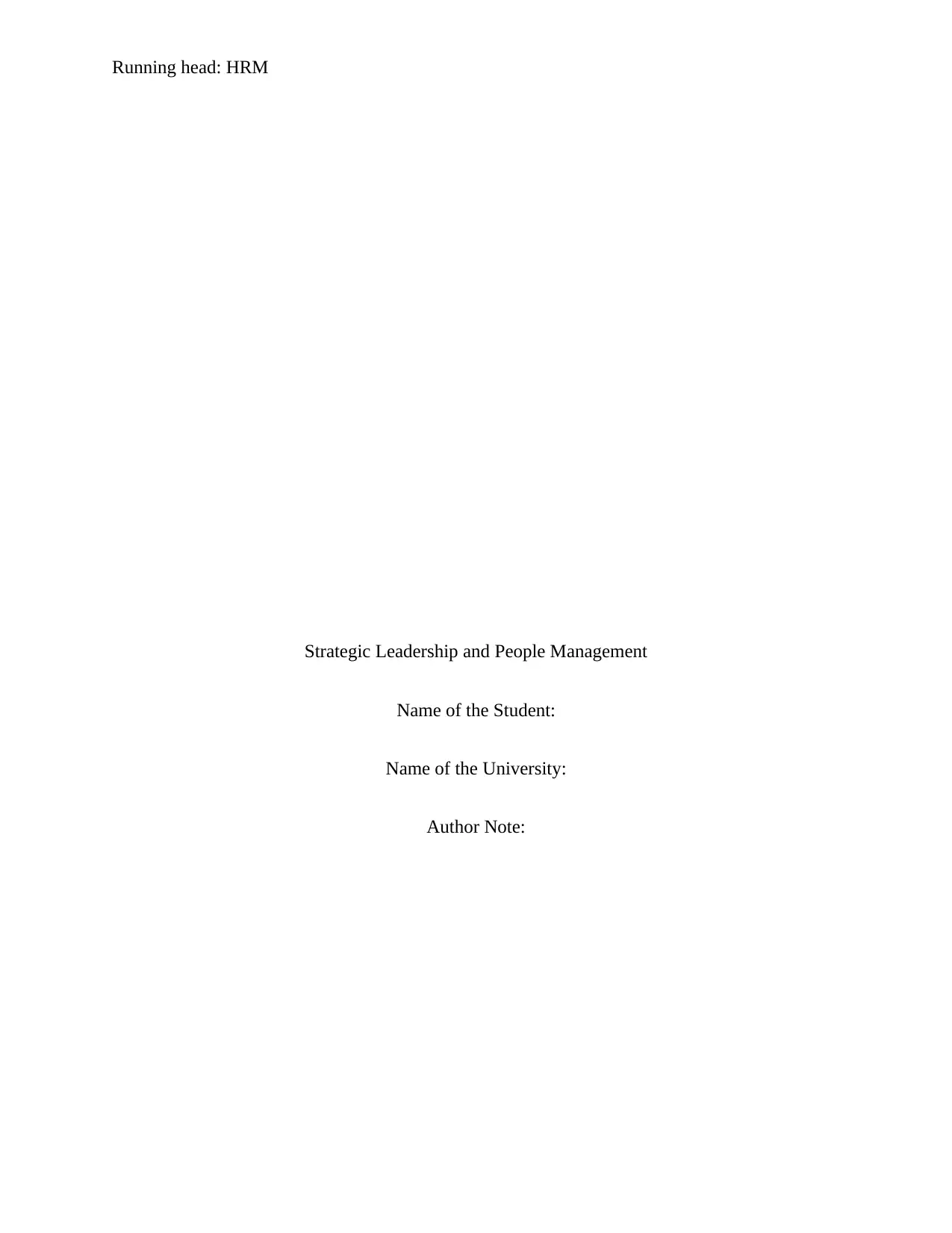
Running head: HRM
Strategic Leadership and People Management
Name of the Student:
Name of the University:
Author Note:
Strategic Leadership and People Management
Name of the Student:
Name of the University:
Author Note:
Secure Best Marks with AI Grader
Need help grading? Try our AI Grader for instant feedback on your assignments.
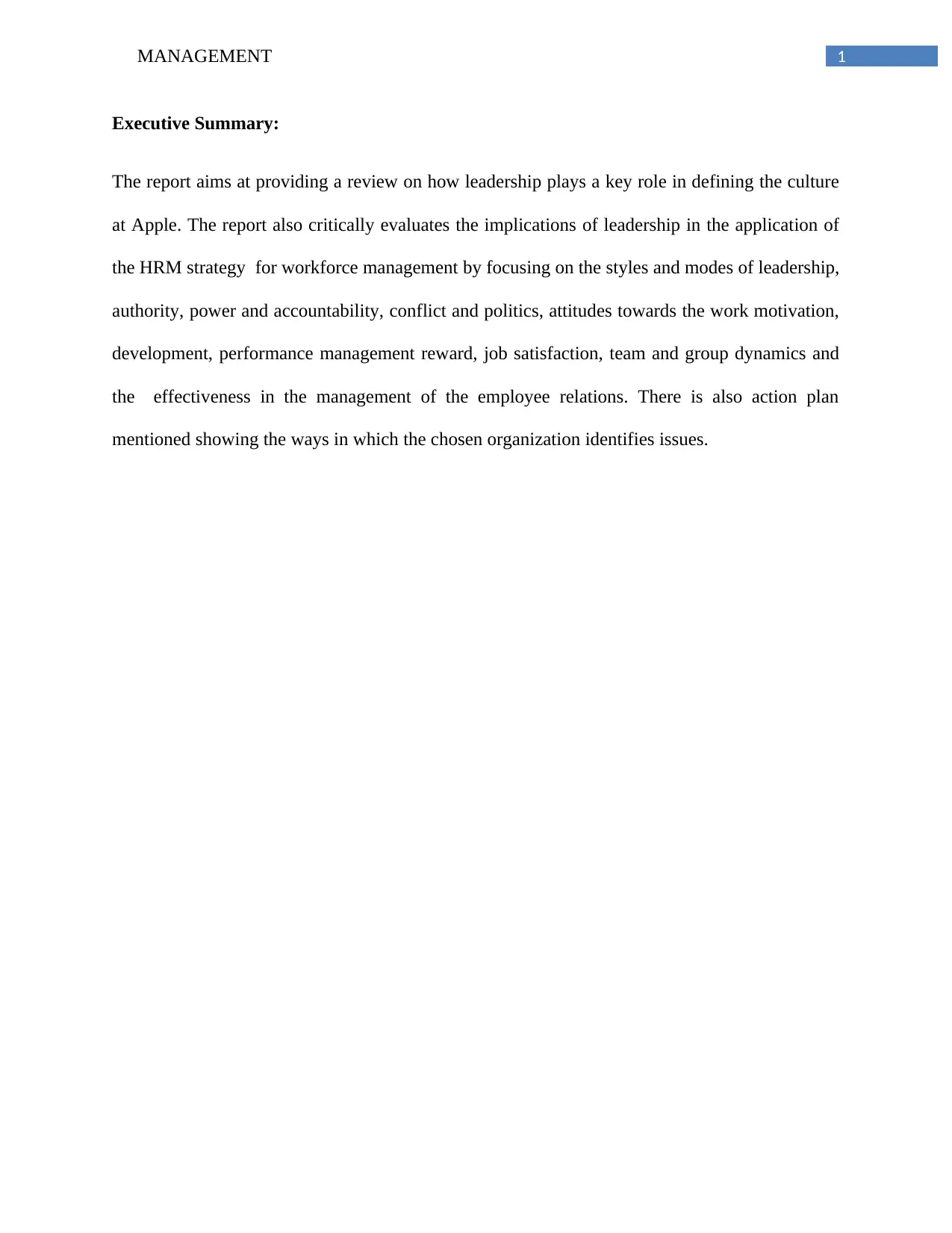
1MANAGEMENT
Executive Summary:
The report aims at providing a review on how leadership plays a key role in defining the culture
at Apple. The report also critically evaluates the implications of leadership in the application of
the HRM strategy for workforce management by focusing on the styles and modes of leadership,
authority, power and accountability, conflict and politics, attitudes towards the work motivation,
development, performance management reward, job satisfaction, team and group dynamics and
the effectiveness in the management of the employee relations. There is also action plan
mentioned showing the ways in which the chosen organization identifies issues.
Executive Summary:
The report aims at providing a review on how leadership plays a key role in defining the culture
at Apple. The report also critically evaluates the implications of leadership in the application of
the HRM strategy for workforce management by focusing on the styles and modes of leadership,
authority, power and accountability, conflict and politics, attitudes towards the work motivation,
development, performance management reward, job satisfaction, team and group dynamics and
the effectiveness in the management of the employee relations. There is also action plan
mentioned showing the ways in which the chosen organization identifies issues.
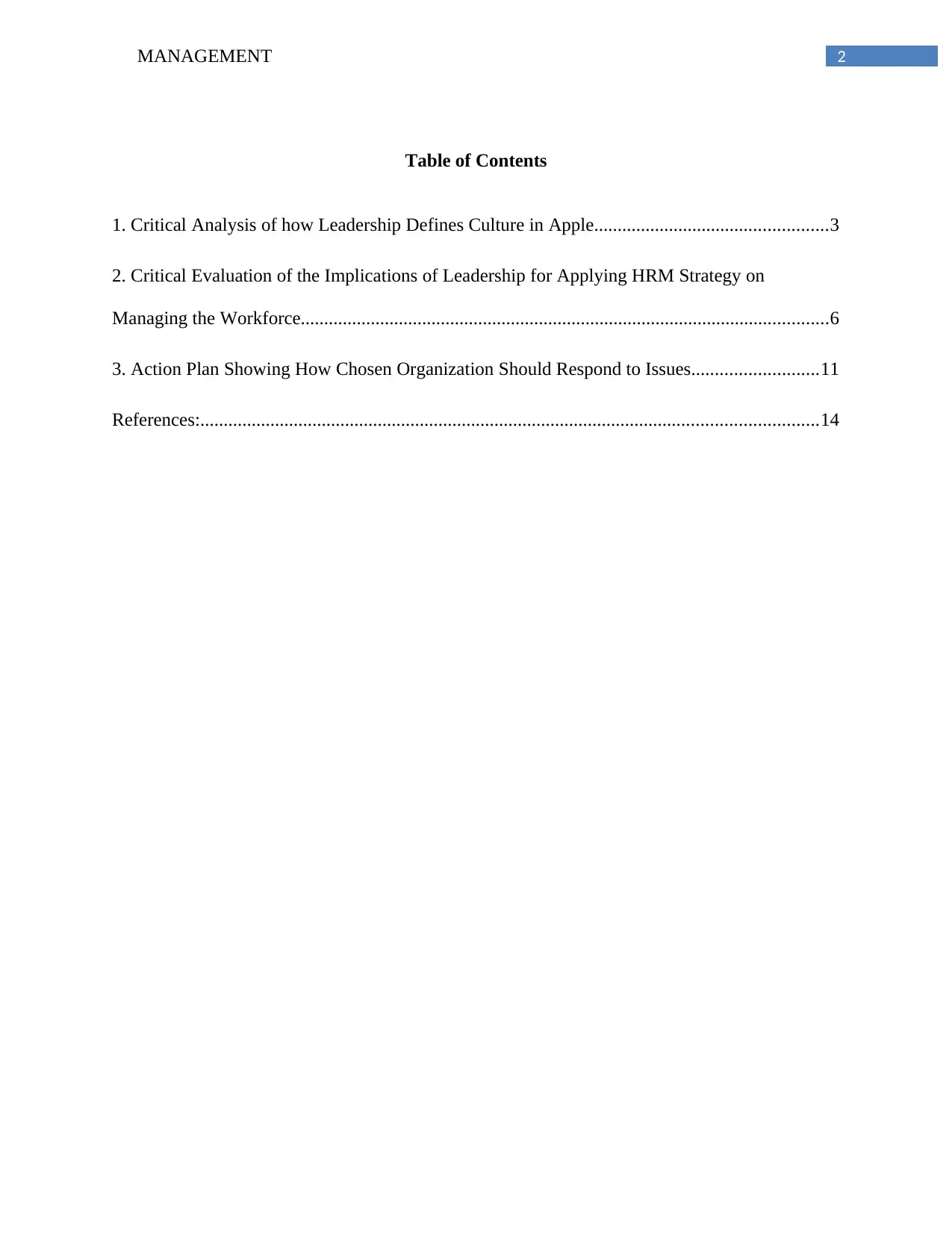
2MANAGEMENT
Table of Contents
1. Critical Analysis of how Leadership Defines Culture in Apple..................................................3
2. Critical Evaluation of the Implications of Leadership for Applying HRM Strategy on
Managing the Workforce.................................................................................................................6
3. Action Plan Showing How Chosen Organization Should Respond to Issues...........................11
References:....................................................................................................................................14
Table of Contents
1. Critical Analysis of how Leadership Defines Culture in Apple..................................................3
2. Critical Evaluation of the Implications of Leadership for Applying HRM Strategy on
Managing the Workforce.................................................................................................................6
3. Action Plan Showing How Chosen Organization Should Respond to Issues...........................11
References:....................................................................................................................................14
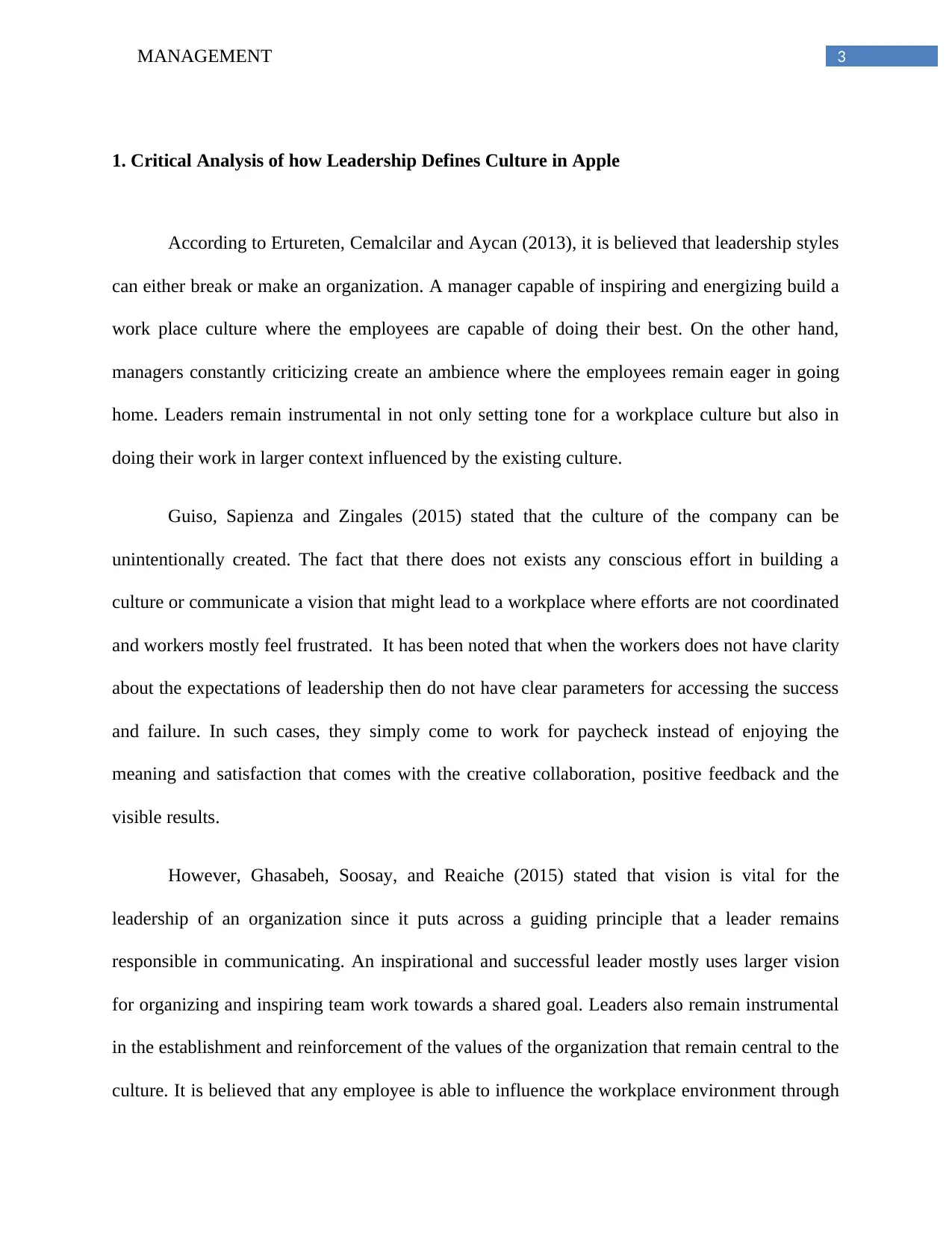
3MANAGEMENT
1. Critical Analysis of how Leadership Defines Culture in Apple
According to Ertureten, Cemalcilar and Aycan (2013), it is believed that leadership styles
can either break or make an organization. A manager capable of inspiring and energizing build a
work place culture where the employees are capable of doing their best. On the other hand,
managers constantly criticizing create an ambience where the employees remain eager in going
home. Leaders remain instrumental in not only setting tone for a workplace culture but also in
doing their work in larger context influenced by the existing culture.
Guiso, Sapienza and Zingales (2015) stated that the culture of the company can be
unintentionally created. The fact that there does not exists any conscious effort in building a
culture or communicate a vision that might lead to a workplace where efforts are not coordinated
and workers mostly feel frustrated. It has been noted that when the workers does not have clarity
about the expectations of leadership then do not have clear parameters for accessing the success
and failure. In such cases, they simply come to work for paycheck instead of enjoying the
meaning and satisfaction that comes with the creative collaboration, positive feedback and the
visible results.
However, Ghasabeh, Soosay, and Reaiche (2015) stated that vision is vital for the
leadership of an organization since it puts across a guiding principle that a leader remains
responsible in communicating. An inspirational and successful leader mostly uses larger vision
for organizing and inspiring team work towards a shared goal. Leaders also remain instrumental
in the establishment and reinforcement of the values of the organization that remain central to the
culture. It is believed that any employee is able to influence the workplace environment through
1. Critical Analysis of how Leadership Defines Culture in Apple
According to Ertureten, Cemalcilar and Aycan (2013), it is believed that leadership styles
can either break or make an organization. A manager capable of inspiring and energizing build a
work place culture where the employees are capable of doing their best. On the other hand,
managers constantly criticizing create an ambience where the employees remain eager in going
home. Leaders remain instrumental in not only setting tone for a workplace culture but also in
doing their work in larger context influenced by the existing culture.
Guiso, Sapienza and Zingales (2015) stated that the culture of the company can be
unintentionally created. The fact that there does not exists any conscious effort in building a
culture or communicate a vision that might lead to a workplace where efforts are not coordinated
and workers mostly feel frustrated. It has been noted that when the workers does not have clarity
about the expectations of leadership then do not have clear parameters for accessing the success
and failure. In such cases, they simply come to work for paycheck instead of enjoying the
meaning and satisfaction that comes with the creative collaboration, positive feedback and the
visible results.
However, Ghasabeh, Soosay, and Reaiche (2015) stated that vision is vital for the
leadership of an organization since it puts across a guiding principle that a leader remains
responsible in communicating. An inspirational and successful leader mostly uses larger vision
for organizing and inspiring team work towards a shared goal. Leaders also remain instrumental
in the establishment and reinforcement of the values of the organization that remain central to the
culture. It is believed that any employee is able to influence the workplace environment through
Secure Best Marks with AI Grader
Need help grading? Try our AI Grader for instant feedback on your assignments.
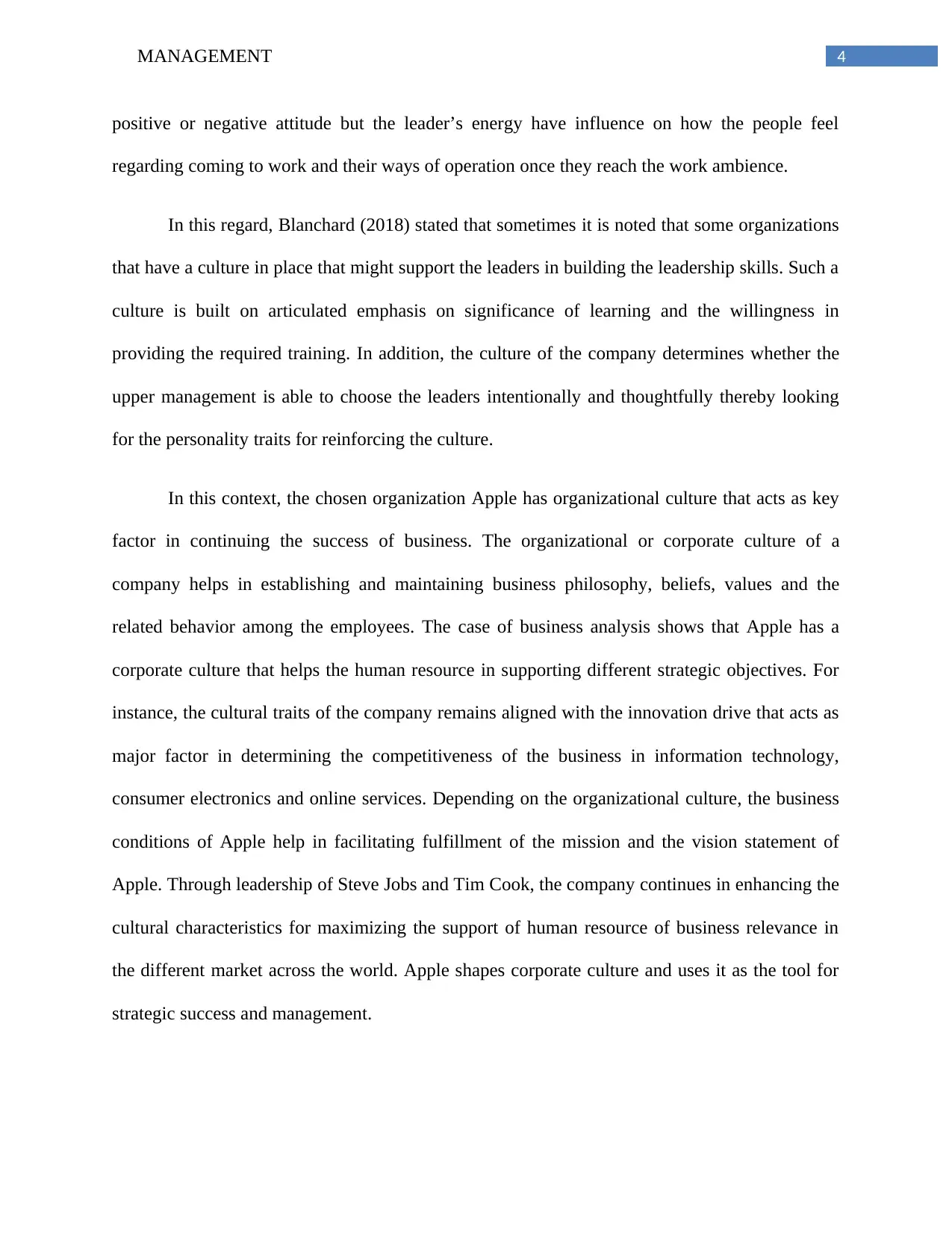
4MANAGEMENT
positive or negative attitude but the leader’s energy have influence on how the people feel
regarding coming to work and their ways of operation once they reach the work ambience.
In this regard, Blanchard (2018) stated that sometimes it is noted that some organizations
that have a culture in place that might support the leaders in building the leadership skills. Such a
culture is built on articulated emphasis on significance of learning and the willingness in
providing the required training. In addition, the culture of the company determines whether the
upper management is able to choose the leaders intentionally and thoughtfully thereby looking
for the personality traits for reinforcing the culture.
In this context, the chosen organization Apple has organizational culture that acts as key
factor in continuing the success of business. The organizational or corporate culture of a
company helps in establishing and maintaining business philosophy, beliefs, values and the
related behavior among the employees. The case of business analysis shows that Apple has a
corporate culture that helps the human resource in supporting different strategic objectives. For
instance, the cultural traits of the company remains aligned with the innovation drive that acts as
major factor in determining the competitiveness of the business in information technology,
consumer electronics and online services. Depending on the organizational culture, the business
conditions of Apple help in facilitating fulfillment of the mission and the vision statement of
Apple. Through leadership of Steve Jobs and Tim Cook, the company continues in enhancing the
cultural characteristics for maximizing the support of human resource of business relevance in
the different market across the world. Apple shapes corporate culture and uses it as the tool for
strategic success and management.
positive or negative attitude but the leader’s energy have influence on how the people feel
regarding coming to work and their ways of operation once they reach the work ambience.
In this regard, Blanchard (2018) stated that sometimes it is noted that some organizations
that have a culture in place that might support the leaders in building the leadership skills. Such a
culture is built on articulated emphasis on significance of learning and the willingness in
providing the required training. In addition, the culture of the company determines whether the
upper management is able to choose the leaders intentionally and thoughtfully thereby looking
for the personality traits for reinforcing the culture.
In this context, the chosen organization Apple has organizational culture that acts as key
factor in continuing the success of business. The organizational or corporate culture of a
company helps in establishing and maintaining business philosophy, beliefs, values and the
related behavior among the employees. The case of business analysis shows that Apple has a
corporate culture that helps the human resource in supporting different strategic objectives. For
instance, the cultural traits of the company remains aligned with the innovation drive that acts as
major factor in determining the competitiveness of the business in information technology,
consumer electronics and online services. Depending on the organizational culture, the business
conditions of Apple help in facilitating fulfillment of the mission and the vision statement of
Apple. Through leadership of Steve Jobs and Tim Cook, the company continues in enhancing the
cultural characteristics for maximizing the support of human resource of business relevance in
the different market across the world. Apple shapes corporate culture and uses it as the tool for
strategic success and management.
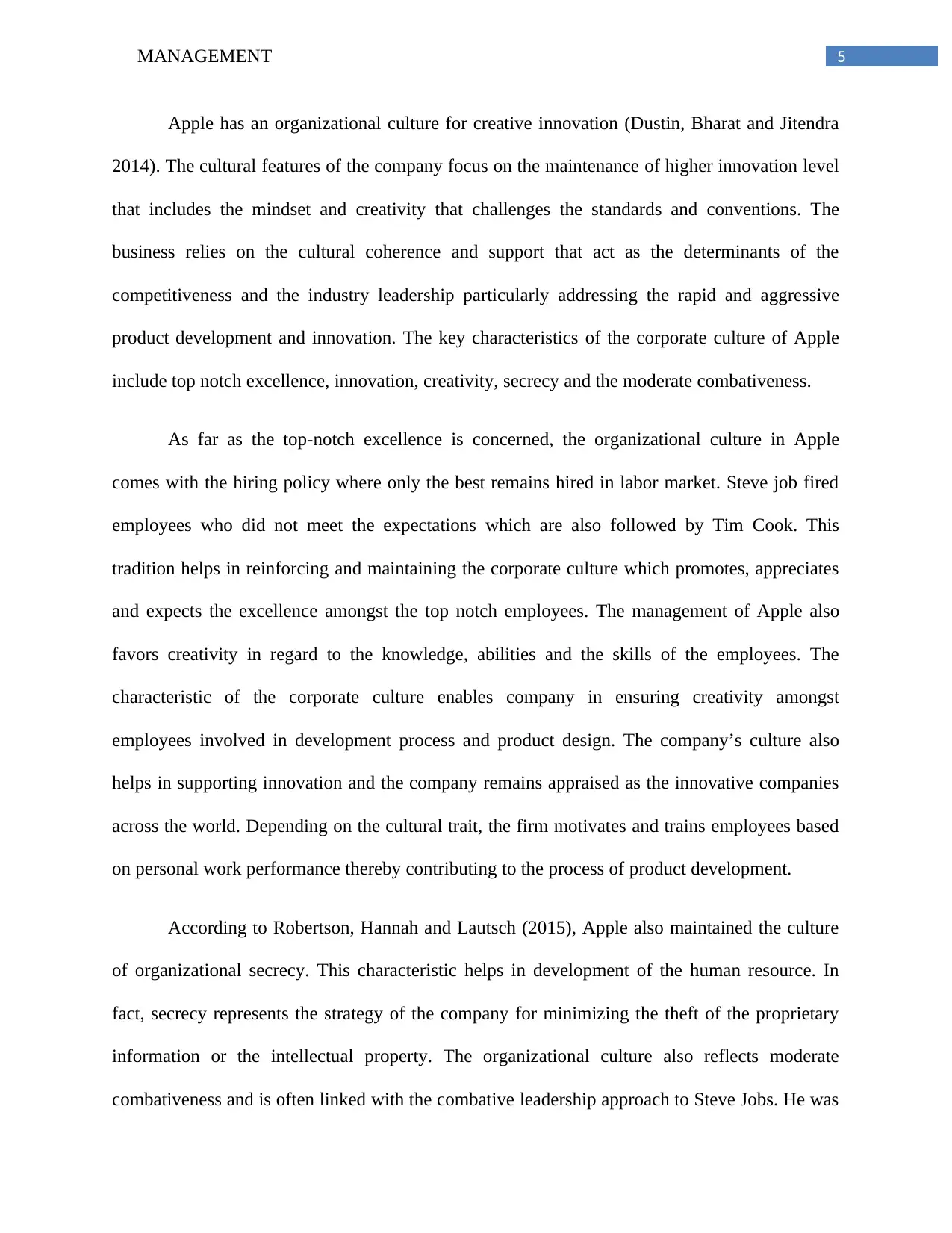
5MANAGEMENT
Apple has an organizational culture for creative innovation (Dustin, Bharat and Jitendra
2014). The cultural features of the company focus on the maintenance of higher innovation level
that includes the mindset and creativity that challenges the standards and conventions. The
business relies on the cultural coherence and support that act as the determinants of the
competitiveness and the industry leadership particularly addressing the rapid and aggressive
product development and innovation. The key characteristics of the corporate culture of Apple
include top notch excellence, innovation, creativity, secrecy and the moderate combativeness.
As far as the top-notch excellence is concerned, the organizational culture in Apple
comes with the hiring policy where only the best remains hired in labor market. Steve job fired
employees who did not meet the expectations which are also followed by Tim Cook. This
tradition helps in reinforcing and maintaining the corporate culture which promotes, appreciates
and expects the excellence amongst the top notch employees. The management of Apple also
favors creativity in regard to the knowledge, abilities and the skills of the employees. The
characteristic of the corporate culture enables company in ensuring creativity amongst
employees involved in development process and product design. The company’s culture also
helps in supporting innovation and the company remains appraised as the innovative companies
across the world. Depending on the cultural trait, the firm motivates and trains employees based
on personal work performance thereby contributing to the process of product development.
According to Robertson, Hannah and Lautsch (2015), Apple also maintained the culture
of organizational secrecy. This characteristic helps in development of the human resource. In
fact, secrecy represents the strategy of the company for minimizing the theft of the proprietary
information or the intellectual property. The organizational culture also reflects moderate
combativeness and is often linked with the combative leadership approach to Steve Jobs. He was
Apple has an organizational culture for creative innovation (Dustin, Bharat and Jitendra
2014). The cultural features of the company focus on the maintenance of higher innovation level
that includes the mindset and creativity that challenges the standards and conventions. The
business relies on the cultural coherence and support that act as the determinants of the
competitiveness and the industry leadership particularly addressing the rapid and aggressive
product development and innovation. The key characteristics of the corporate culture of Apple
include top notch excellence, innovation, creativity, secrecy and the moderate combativeness.
As far as the top-notch excellence is concerned, the organizational culture in Apple
comes with the hiring policy where only the best remains hired in labor market. Steve job fired
employees who did not meet the expectations which are also followed by Tim Cook. This
tradition helps in reinforcing and maintaining the corporate culture which promotes, appreciates
and expects the excellence amongst the top notch employees. The management of Apple also
favors creativity in regard to the knowledge, abilities and the skills of the employees. The
characteristic of the corporate culture enables company in ensuring creativity amongst
employees involved in development process and product design. The company’s culture also
helps in supporting innovation and the company remains appraised as the innovative companies
across the world. Depending on the cultural trait, the firm motivates and trains employees based
on personal work performance thereby contributing to the process of product development.
According to Robertson, Hannah and Lautsch (2015), Apple also maintained the culture
of organizational secrecy. This characteristic helps in development of the human resource. In
fact, secrecy represents the strategy of the company for minimizing the theft of the proprietary
information or the intellectual property. The organizational culture also reflects moderate
combativeness and is often linked with the combative leadership approach to Steve Jobs. He was
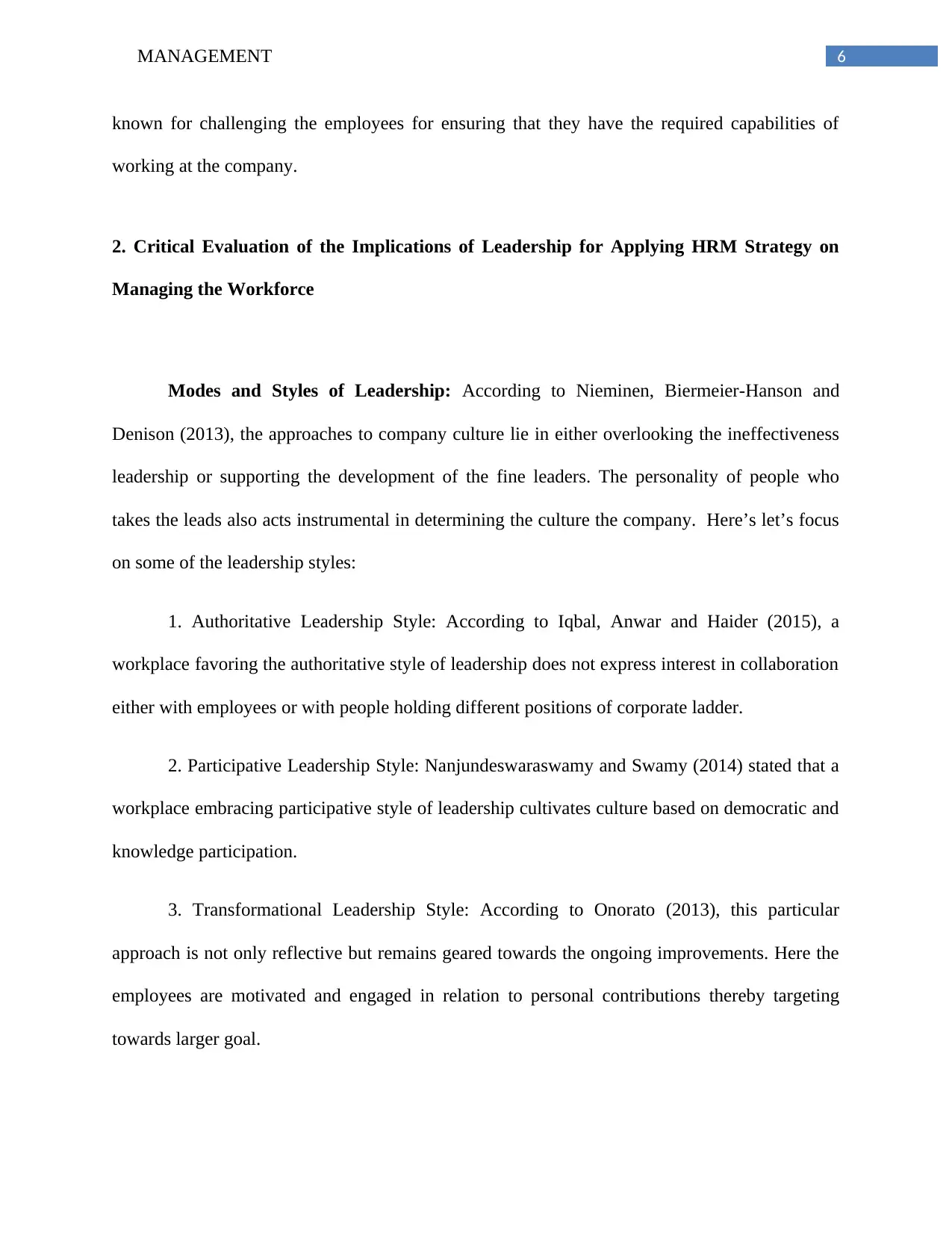
6MANAGEMENT
known for challenging the employees for ensuring that they have the required capabilities of
working at the company.
2. Critical Evaluation of the Implications of Leadership for Applying HRM Strategy on
Managing the Workforce
Modes and Styles of Leadership: According to Nieminen, Biermeier-Hanson and
Denison (2013), the approaches to company culture lie in either overlooking the ineffectiveness
leadership or supporting the development of the fine leaders. The personality of people who
takes the leads also acts instrumental in determining the culture the company. Here’s let’s focus
on some of the leadership styles:
1. Authoritative Leadership Style: According to Iqbal, Anwar and Haider (2015), a
workplace favoring the authoritative style of leadership does not express interest in collaboration
either with employees or with people holding different positions of corporate ladder.
2. Participative Leadership Style: Nanjundeswaraswamy and Swamy (2014) stated that a
workplace embracing participative style of leadership cultivates culture based on democratic and
knowledge participation.
3. Transformational Leadership Style: According to Onorato (2013), this particular
approach is not only reflective but remains geared towards the ongoing improvements. Here the
employees are motivated and engaged in relation to personal contributions thereby targeting
towards larger goal.
known for challenging the employees for ensuring that they have the required capabilities of
working at the company.
2. Critical Evaluation of the Implications of Leadership for Applying HRM Strategy on
Managing the Workforce
Modes and Styles of Leadership: According to Nieminen, Biermeier-Hanson and
Denison (2013), the approaches to company culture lie in either overlooking the ineffectiveness
leadership or supporting the development of the fine leaders. The personality of people who
takes the leads also acts instrumental in determining the culture the company. Here’s let’s focus
on some of the leadership styles:
1. Authoritative Leadership Style: According to Iqbal, Anwar and Haider (2015), a
workplace favoring the authoritative style of leadership does not express interest in collaboration
either with employees or with people holding different positions of corporate ladder.
2. Participative Leadership Style: Nanjundeswaraswamy and Swamy (2014) stated that a
workplace embracing participative style of leadership cultivates culture based on democratic and
knowledge participation.
3. Transformational Leadership Style: According to Onorato (2013), this particular
approach is not only reflective but remains geared towards the ongoing improvements. Here the
employees are motivated and engaged in relation to personal contributions thereby targeting
towards larger goal.
Paraphrase This Document
Need a fresh take? Get an instant paraphrase of this document with our AI Paraphraser
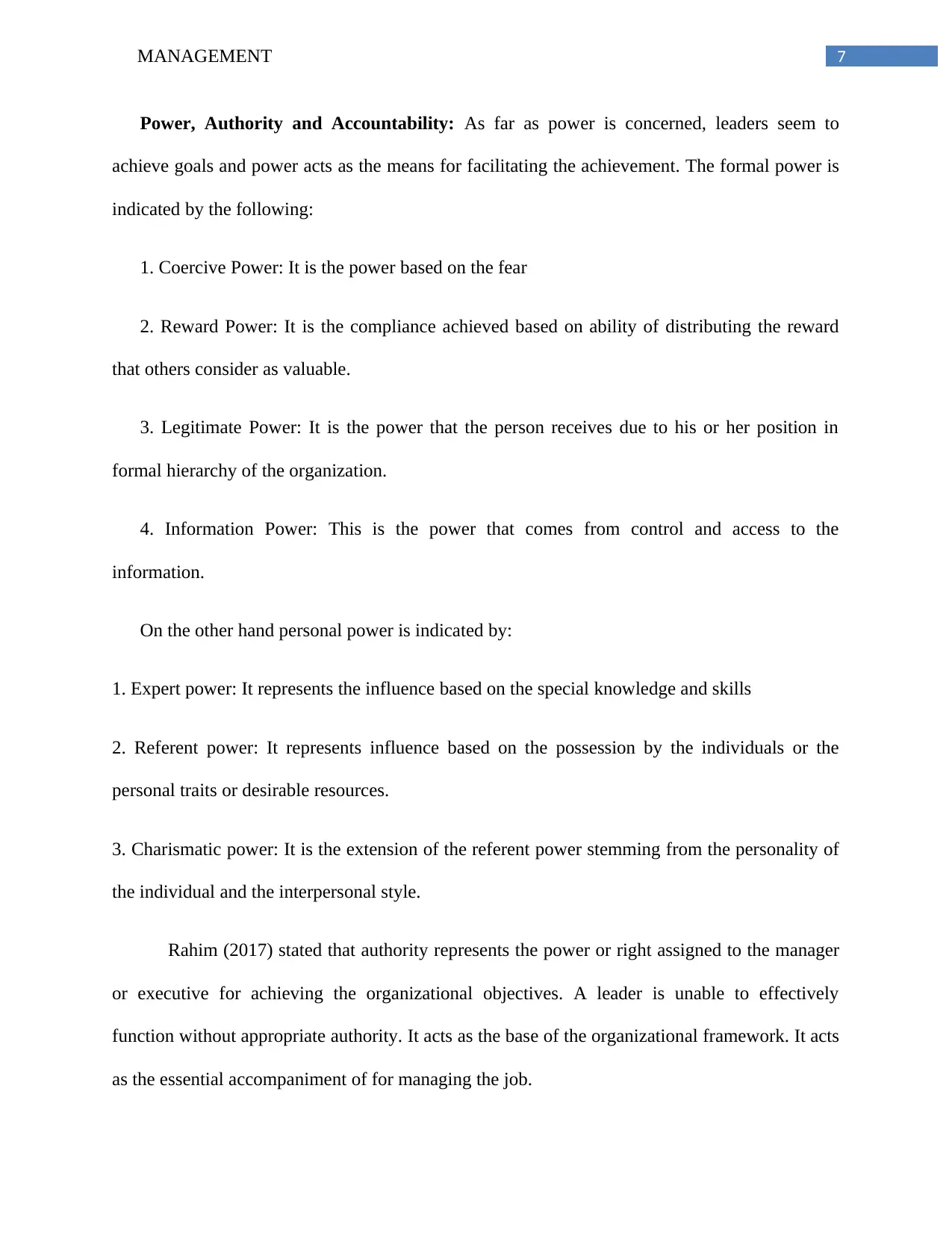
7MANAGEMENT
Power, Authority and Accountability: As far as power is concerned, leaders seem to
achieve goals and power acts as the means for facilitating the achievement. The formal power is
indicated by the following:
1. Coercive Power: It is the power based on the fear
2. Reward Power: It is the compliance achieved based on ability of distributing the reward
that others consider as valuable.
3. Legitimate Power: It is the power that the person receives due to his or her position in
formal hierarchy of the organization.
4. Information Power: This is the power that comes from control and access to the
information.
On the other hand personal power is indicated by:
1. Expert power: It represents the influence based on the special knowledge and skills
2. Referent power: It represents influence based on the possession by the individuals or the
personal traits or desirable resources.
3. Charismatic power: It is the extension of the referent power stemming from the personality of
the individual and the interpersonal style.
Rahim (2017) stated that authority represents the power or right assigned to the manager
or executive for achieving the organizational objectives. A leader is unable to effectively
function without appropriate authority. It acts as the base of the organizational framework. It acts
as the essential accompaniment of for managing the job.
Power, Authority and Accountability: As far as power is concerned, leaders seem to
achieve goals and power acts as the means for facilitating the achievement. The formal power is
indicated by the following:
1. Coercive Power: It is the power based on the fear
2. Reward Power: It is the compliance achieved based on ability of distributing the reward
that others consider as valuable.
3. Legitimate Power: It is the power that the person receives due to his or her position in
formal hierarchy of the organization.
4. Information Power: This is the power that comes from control and access to the
information.
On the other hand personal power is indicated by:
1. Expert power: It represents the influence based on the special knowledge and skills
2. Referent power: It represents influence based on the possession by the individuals or the
personal traits or desirable resources.
3. Charismatic power: It is the extension of the referent power stemming from the personality of
the individual and the interpersonal style.
Rahim (2017) stated that authority represents the power or right assigned to the manager
or executive for achieving the organizational objectives. A leader is unable to effectively
function without appropriate authority. It acts as the base of the organizational framework. It acts
as the essential accompaniment of for managing the job.
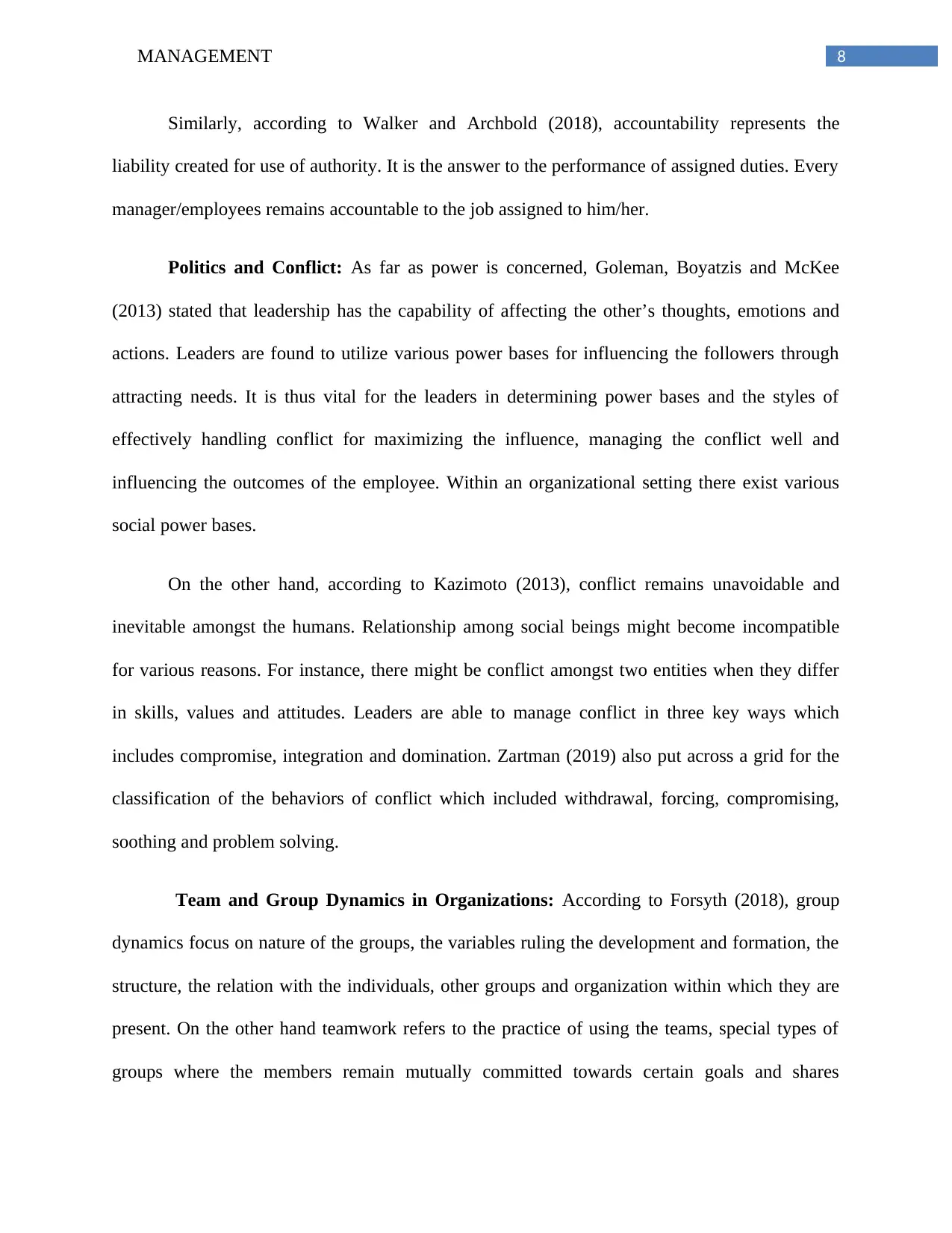
8MANAGEMENT
Similarly, according to Walker and Archbold (2018), accountability represents the
liability created for use of authority. It is the answer to the performance of assigned duties. Every
manager/employees remains accountable to the job assigned to him/her.
Politics and Conflict: As far as power is concerned, Goleman, Boyatzis and McKee
(2013) stated that leadership has the capability of affecting the other’s thoughts, emotions and
actions. Leaders are found to utilize various power bases for influencing the followers through
attracting needs. It is thus vital for the leaders in determining power bases and the styles of
effectively handling conflict for maximizing the influence, managing the conflict well and
influencing the outcomes of the employee. Within an organizational setting there exist various
social power bases.
On the other hand, according to Kazimoto (2013), conflict remains unavoidable and
inevitable amongst the humans. Relationship among social beings might become incompatible
for various reasons. For instance, there might be conflict amongst two entities when they differ
in skills, values and attitudes. Leaders are able to manage conflict in three key ways which
includes compromise, integration and domination. Zartman (2019) also put across a grid for the
classification of the behaviors of conflict which included withdrawal, forcing, compromising,
soothing and problem solving.
Team and Group Dynamics in Organizations: According to Forsyth (2018), group
dynamics focus on nature of the groups, the variables ruling the development and formation, the
structure, the relation with the individuals, other groups and organization within which they are
present. On the other hand teamwork refers to the practice of using the teams, special types of
groups where the members remain mutually committed towards certain goals and shares
Similarly, according to Walker and Archbold (2018), accountability represents the
liability created for use of authority. It is the answer to the performance of assigned duties. Every
manager/employees remains accountable to the job assigned to him/her.
Politics and Conflict: As far as power is concerned, Goleman, Boyatzis and McKee
(2013) stated that leadership has the capability of affecting the other’s thoughts, emotions and
actions. Leaders are found to utilize various power bases for influencing the followers through
attracting needs. It is thus vital for the leaders in determining power bases and the styles of
effectively handling conflict for maximizing the influence, managing the conflict well and
influencing the outcomes of the employee. Within an organizational setting there exist various
social power bases.
On the other hand, according to Kazimoto (2013), conflict remains unavoidable and
inevitable amongst the humans. Relationship among social beings might become incompatible
for various reasons. For instance, there might be conflict amongst two entities when they differ
in skills, values and attitudes. Leaders are able to manage conflict in three key ways which
includes compromise, integration and domination. Zartman (2019) also put across a grid for the
classification of the behaviors of conflict which included withdrawal, forcing, compromising,
soothing and problem solving.
Team and Group Dynamics in Organizations: According to Forsyth (2018), group
dynamics focus on nature of the groups, the variables ruling the development and formation, the
structure, the relation with the individuals, other groups and organization within which they are
present. On the other hand teamwork refers to the practice of using the teams, special types of
groups where the members remain mutually committed towards certain goals and shares
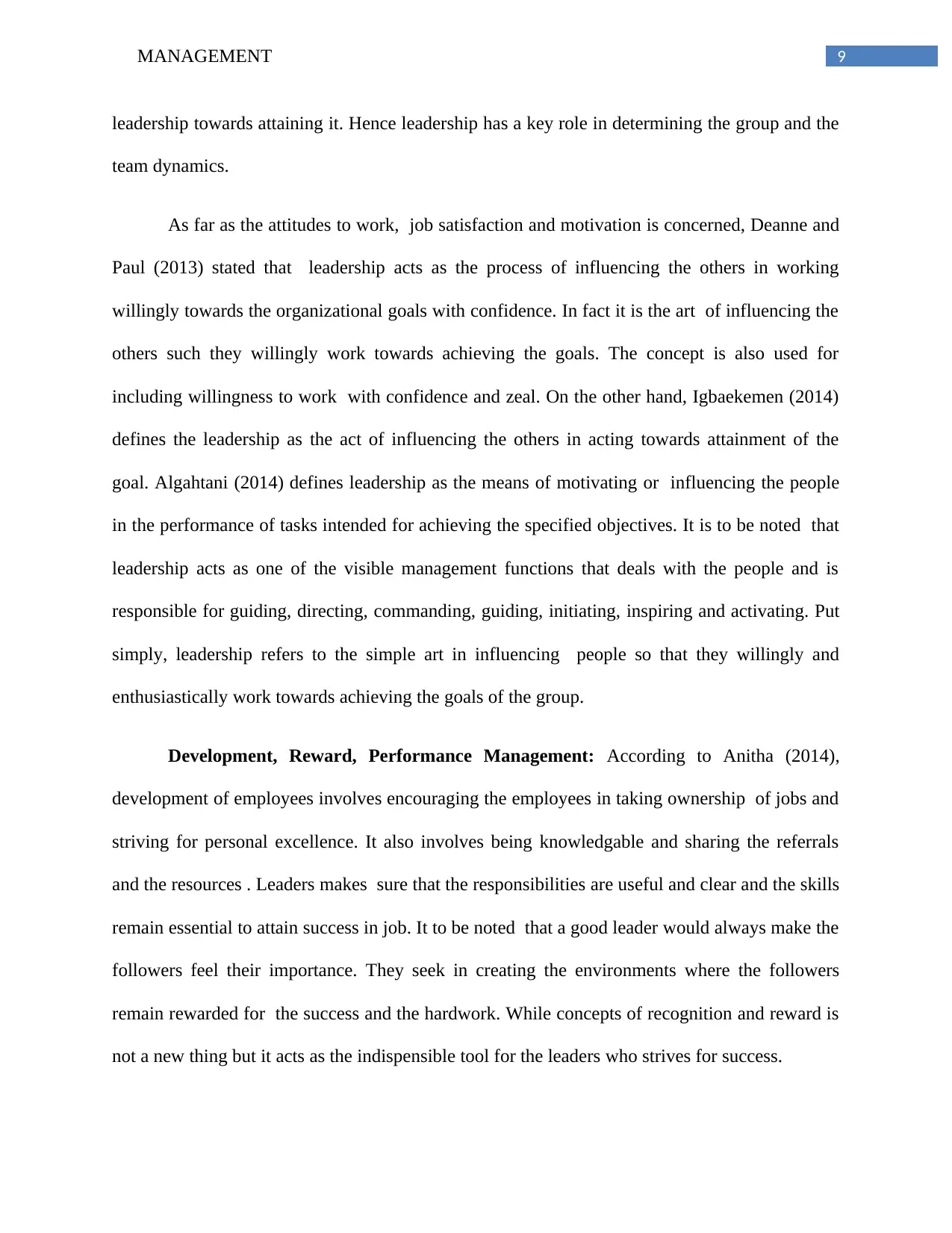
9MANAGEMENT
leadership towards attaining it. Hence leadership has a key role in determining the group and the
team dynamics.
As far as the attitudes to work, job satisfaction and motivation is concerned, Deanne and
Paul (2013) stated that leadership acts as the process of influencing the others in working
willingly towards the organizational goals with confidence. In fact it is the art of influencing the
others such they willingly work towards achieving the goals. The concept is also used for
including willingness to work with confidence and zeal. On the other hand, Igbaekemen (2014)
defines the leadership as the act of influencing the others in acting towards attainment of the
goal. Algahtani (2014) defines leadership as the means of motivating or influencing the people
in the performance of tasks intended for achieving the specified objectives. It is to be noted that
leadership acts as one of the visible management functions that deals with the people and is
responsible for guiding, directing, commanding, guiding, initiating, inspiring and activating. Put
simply, leadership refers to the simple art in influencing people so that they willingly and
enthusiastically work towards achieving the goals of the group.
Development, Reward, Performance Management: According to Anitha (2014),
development of employees involves encouraging the employees in taking ownership of jobs and
striving for personal excellence. It also involves being knowledgable and sharing the referrals
and the resources . Leaders makes sure that the responsibilities are useful and clear and the skills
remain essential to attain success in job. It to be noted that a good leader would always make the
followers feel their importance. They seek in creating the environments where the followers
remain rewarded for the success and the hardwork. While concepts of recognition and reward is
not a new thing but it acts as the indispensible tool for the leaders who strives for success.
leadership towards attaining it. Hence leadership has a key role in determining the group and the
team dynamics.
As far as the attitudes to work, job satisfaction and motivation is concerned, Deanne and
Paul (2013) stated that leadership acts as the process of influencing the others in working
willingly towards the organizational goals with confidence. In fact it is the art of influencing the
others such they willingly work towards achieving the goals. The concept is also used for
including willingness to work with confidence and zeal. On the other hand, Igbaekemen (2014)
defines the leadership as the act of influencing the others in acting towards attainment of the
goal. Algahtani (2014) defines leadership as the means of motivating or influencing the people
in the performance of tasks intended for achieving the specified objectives. It is to be noted that
leadership acts as one of the visible management functions that deals with the people and is
responsible for guiding, directing, commanding, guiding, initiating, inspiring and activating. Put
simply, leadership refers to the simple art in influencing people so that they willingly and
enthusiastically work towards achieving the goals of the group.
Development, Reward, Performance Management: According to Anitha (2014),
development of employees involves encouraging the employees in taking ownership of jobs and
striving for personal excellence. It also involves being knowledgable and sharing the referrals
and the resources . Leaders makes sure that the responsibilities are useful and clear and the skills
remain essential to attain success in job. It to be noted that a good leader would always make the
followers feel their importance. They seek in creating the environments where the followers
remain rewarded for the success and the hardwork. While concepts of recognition and reward is
not a new thing but it acts as the indispensible tool for the leaders who strives for success.
Secure Best Marks with AI Grader
Need help grading? Try our AI Grader for instant feedback on your assignments.
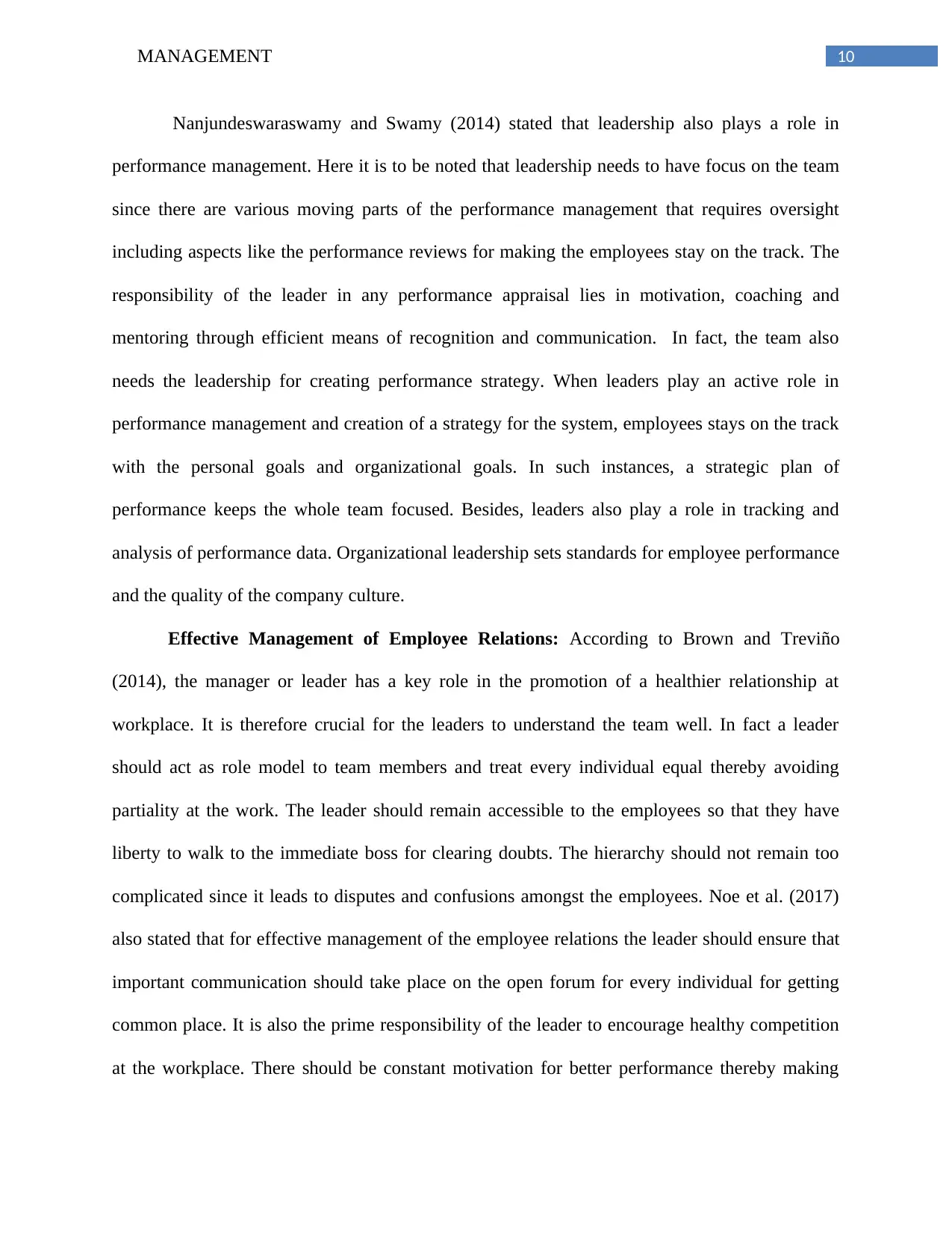
10MANAGEMENT
Nanjundeswaraswamy and Swamy (2014) stated that leadership also plays a role in
performance management. Here it is to be noted that leadership needs to have focus on the team
since there are various moving parts of the performance management that requires oversight
including aspects like the performance reviews for making the employees stay on the track. The
responsibility of the leader in any performance appraisal lies in motivation, coaching and
mentoring through efficient means of recognition and communication. In fact, the team also
needs the leadership for creating performance strategy. When leaders play an active role in
performance management and creation of a strategy for the system, employees stays on the track
with the personal goals and organizational goals. In such instances, a strategic plan of
performance keeps the whole team focused. Besides, leaders also play a role in tracking and
analysis of performance data. Organizational leadership sets standards for employee performance
and the quality of the company culture.
Effective Management of Employee Relations: According to Brown and Treviño
(2014), the manager or leader has a key role in the promotion of a healthier relationship at
workplace. It is therefore crucial for the leaders to understand the team well. In fact a leader
should act as role model to team members and treat every individual equal thereby avoiding
partiality at the work. The leader should remain accessible to the employees so that they have
liberty to walk to the immediate boss for clearing doubts. The hierarchy should not remain too
complicated since it leads to disputes and confusions amongst the employees. Noe et al. (2017)
also stated that for effective management of the employee relations the leader should ensure that
important communication should take place on the open forum for every individual for getting
common place. It is also the prime responsibility of the leader to encourage healthy competition
at the workplace. There should be constant motivation for better performance thereby making
Nanjundeswaraswamy and Swamy (2014) stated that leadership also plays a role in
performance management. Here it is to be noted that leadership needs to have focus on the team
since there are various moving parts of the performance management that requires oversight
including aspects like the performance reviews for making the employees stay on the track. The
responsibility of the leader in any performance appraisal lies in motivation, coaching and
mentoring through efficient means of recognition and communication. In fact, the team also
needs the leadership for creating performance strategy. When leaders play an active role in
performance management and creation of a strategy for the system, employees stays on the track
with the personal goals and organizational goals. In such instances, a strategic plan of
performance keeps the whole team focused. Besides, leaders also play a role in tracking and
analysis of performance data. Organizational leadership sets standards for employee performance
and the quality of the company culture.
Effective Management of Employee Relations: According to Brown and Treviño
(2014), the manager or leader has a key role in the promotion of a healthier relationship at
workplace. It is therefore crucial for the leaders to understand the team well. In fact a leader
should act as role model to team members and treat every individual equal thereby avoiding
partiality at the work. The leader should remain accessible to the employees so that they have
liberty to walk to the immediate boss for clearing doubts. The hierarchy should not remain too
complicated since it leads to disputes and confusions amongst the employees. Noe et al. (2017)
also stated that for effective management of the employee relations the leader should ensure that
important communication should take place on the open forum for every individual for getting
common place. It is also the prime responsibility of the leader to encourage healthy competition
at the workplace. There should be constant motivation for better performance thereby making
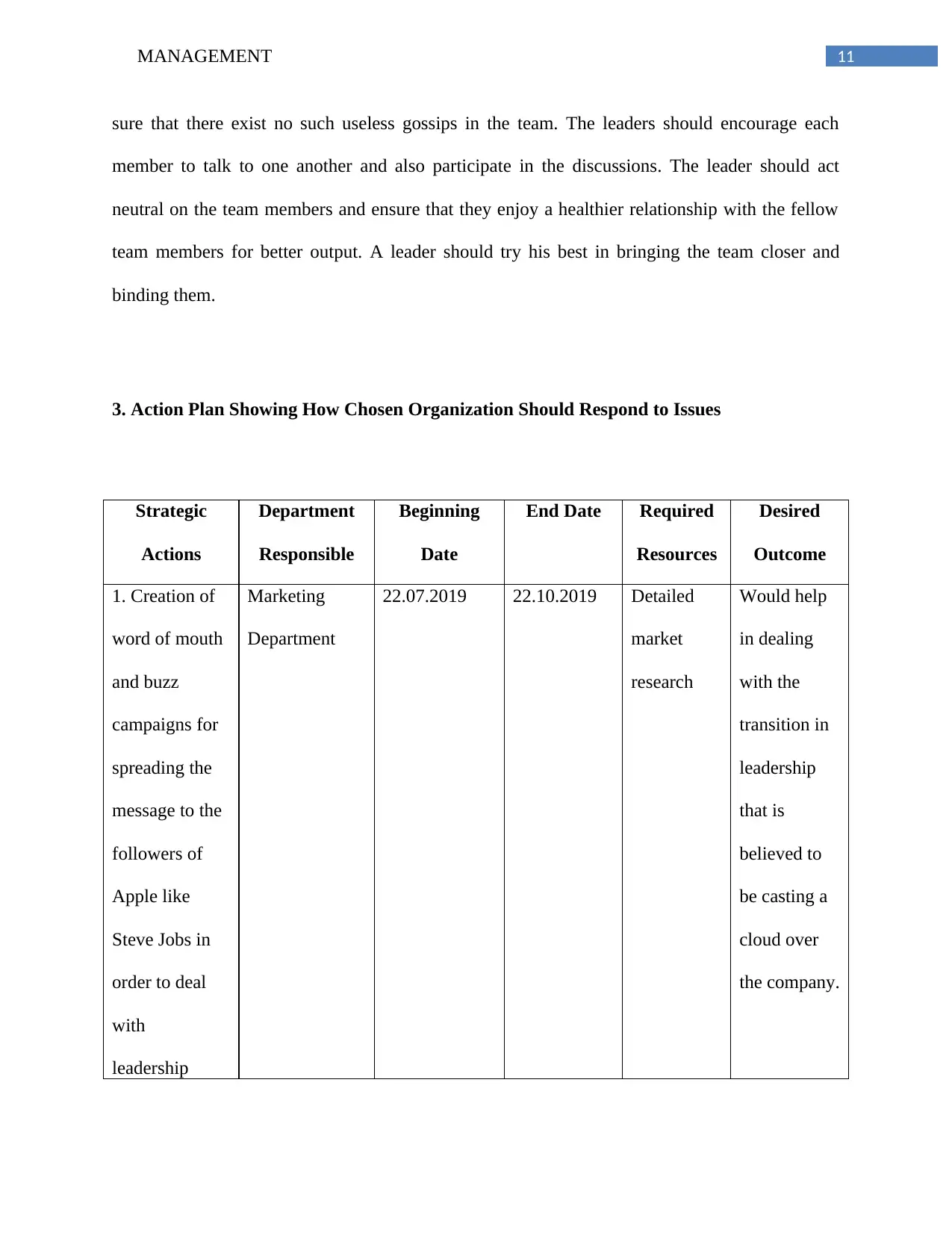
11MANAGEMENT
sure that there exist no such useless gossips in the team. The leaders should encourage each
member to talk to one another and also participate in the discussions. The leader should act
neutral on the team members and ensure that they enjoy a healthier relationship with the fellow
team members for better output. A leader should try his best in bringing the team closer and
binding them.
3. Action Plan Showing How Chosen Organization Should Respond to Issues
Strategic
Actions
Department
Responsible
Beginning
Date
End Date Required
Resources
Desired
Outcome
1. Creation of
word of mouth
and buzz
campaigns for
spreading the
message to the
followers of
Apple like
Steve Jobs in
order to deal
with
leadership
Marketing
Department
22.07.2019 22.10.2019 Detailed
market
research
Would help
in dealing
with the
transition in
leadership
that is
believed to
be casting a
cloud over
the company.
sure that there exist no such useless gossips in the team. The leaders should encourage each
member to talk to one another and also participate in the discussions. The leader should act
neutral on the team members and ensure that they enjoy a healthier relationship with the fellow
team members for better output. A leader should try his best in bringing the team closer and
binding them.
3. Action Plan Showing How Chosen Organization Should Respond to Issues
Strategic
Actions
Department
Responsible
Beginning
Date
End Date Required
Resources
Desired
Outcome
1. Creation of
word of mouth
and buzz
campaigns for
spreading the
message to the
followers of
Apple like
Steve Jobs in
order to deal
with
leadership
Marketing
Department
22.07.2019 22.10.2019 Detailed
market
research
Would help
in dealing
with the
transition in
leadership
that is
believed to
be casting a
cloud over
the company.
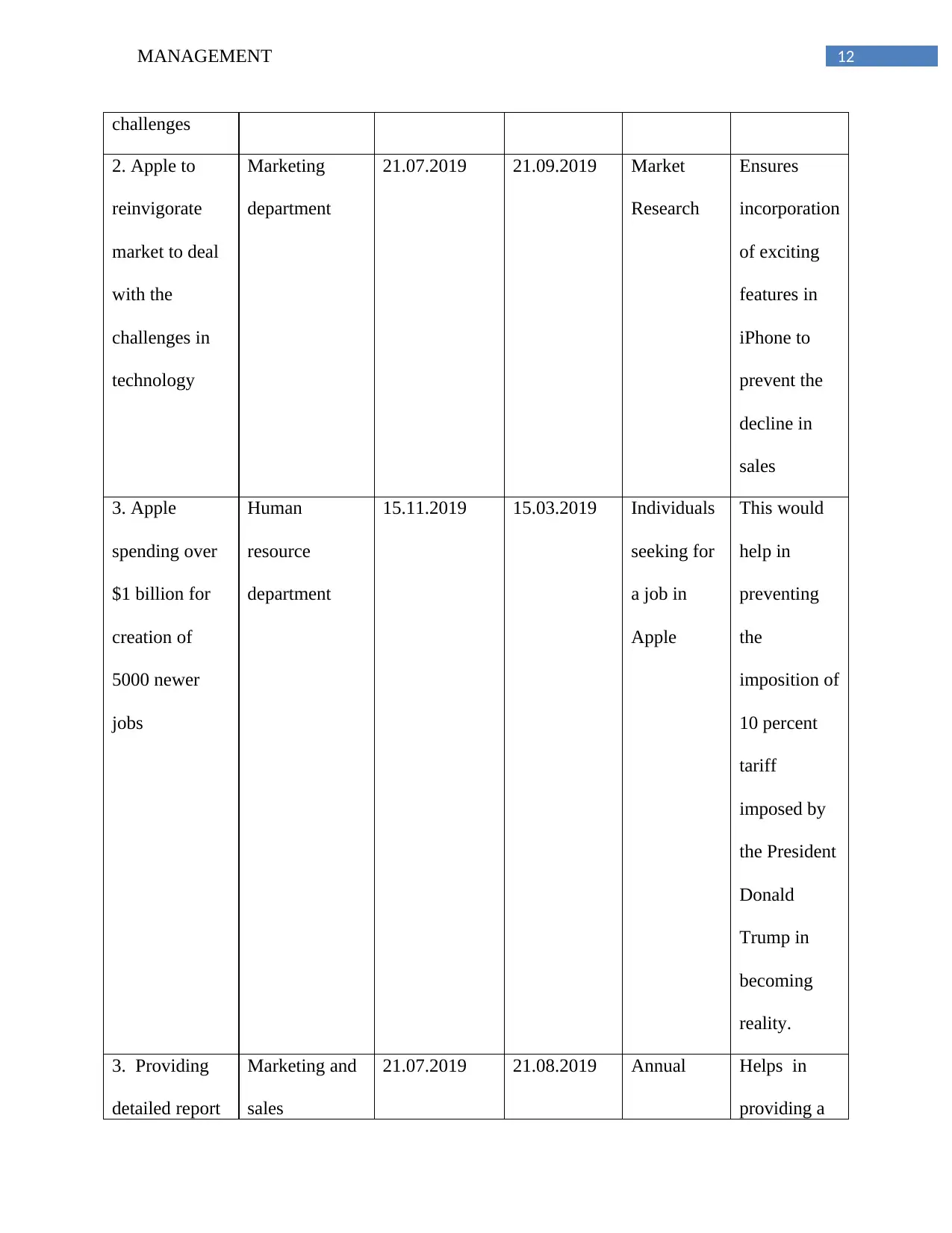
12MANAGEMENT
challenges
2. Apple to
reinvigorate
market to deal
with the
challenges in
technology
Marketing
department
21.07.2019 21.09.2019 Market
Research
Ensures
incorporation
of exciting
features in
iPhone to
prevent the
decline in
sales
3. Apple
spending over
$1 billion for
creation of
5000 newer
jobs
Human
resource
department
15.11.2019 15.03.2019 Individuals
seeking for
a job in
Apple
This would
help in
preventing
the
imposition of
10 percent
tariff
imposed by
the President
Donald
Trump in
becoming
reality.
3. Providing
detailed report
Marketing and
sales
21.07.2019 21.08.2019 Annual Helps in
providing a
challenges
2. Apple to
reinvigorate
market to deal
with the
challenges in
technology
Marketing
department
21.07.2019 21.09.2019 Market
Research
Ensures
incorporation
of exciting
features in
iPhone to
prevent the
decline in
sales
3. Apple
spending over
$1 billion for
creation of
5000 newer
jobs
Human
resource
department
15.11.2019 15.03.2019 Individuals
seeking for
a job in
Apple
This would
help in
preventing
the
imposition of
10 percent
tariff
imposed by
the President
Donald
Trump in
becoming
reality.
3. Providing
detailed report
Marketing and
sales
21.07.2019 21.08.2019 Annual Helps in
providing a
Paraphrase This Document
Need a fresh take? Get an instant paraphrase of this document with our AI Paraphraser
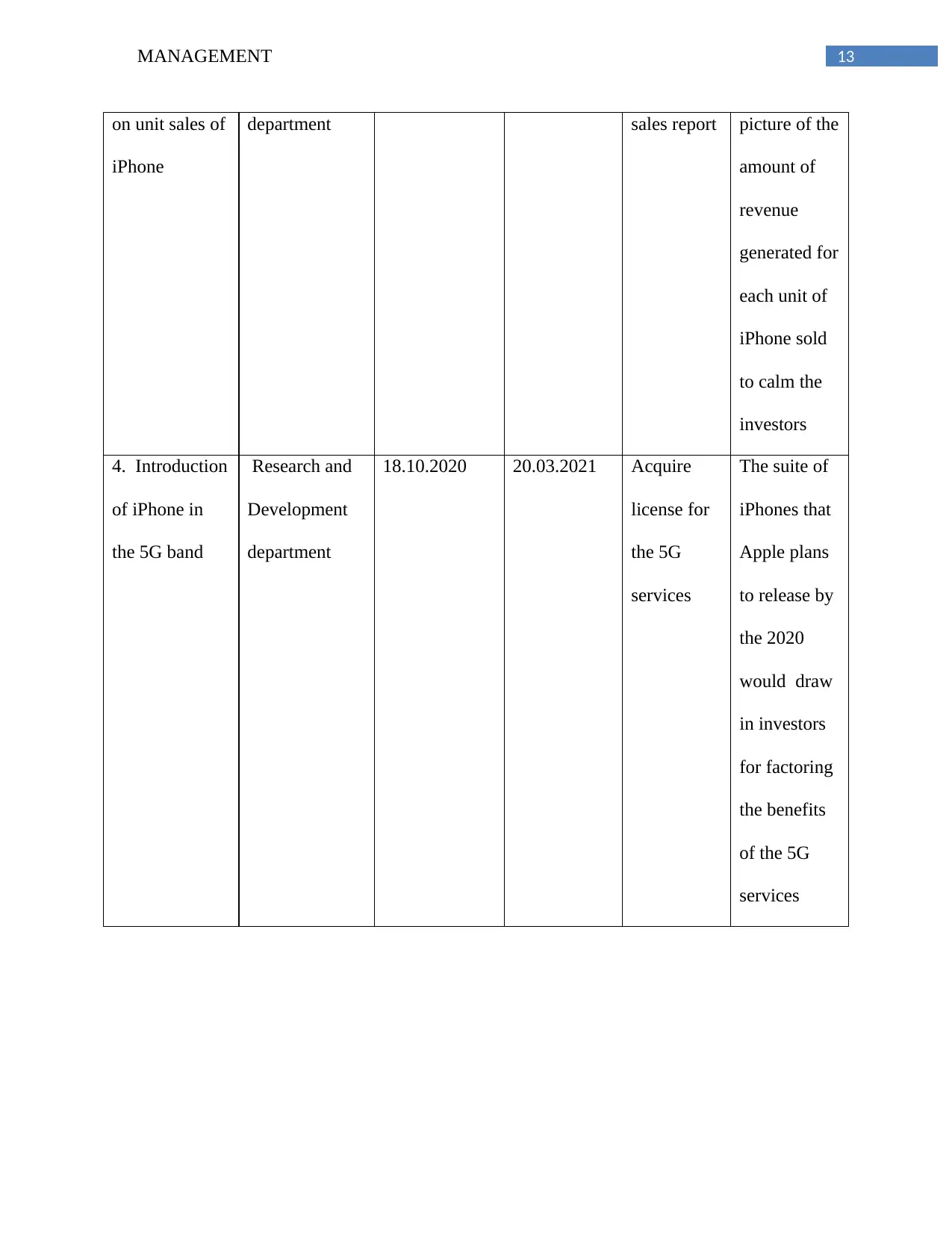
13MANAGEMENT
on unit sales of
iPhone
department sales report picture of the
amount of
revenue
generated for
each unit of
iPhone sold
to calm the
investors
4. Introduction
of iPhone in
the 5G band
Research and
Development
department
18.10.2020 20.03.2021 Acquire
license for
the 5G
services
The suite of
iPhones that
Apple plans
to release by
the 2020
would draw
in investors
for factoring
the benefits
of the 5G
services
on unit sales of
iPhone
department sales report picture of the
amount of
revenue
generated for
each unit of
iPhone sold
to calm the
investors
4. Introduction
of iPhone in
the 5G band
Research and
Development
department
18.10.2020 20.03.2021 Acquire
license for
the 5G
services
The suite of
iPhones that
Apple plans
to release by
the 2020
would draw
in investors
for factoring
the benefits
of the 5G
services
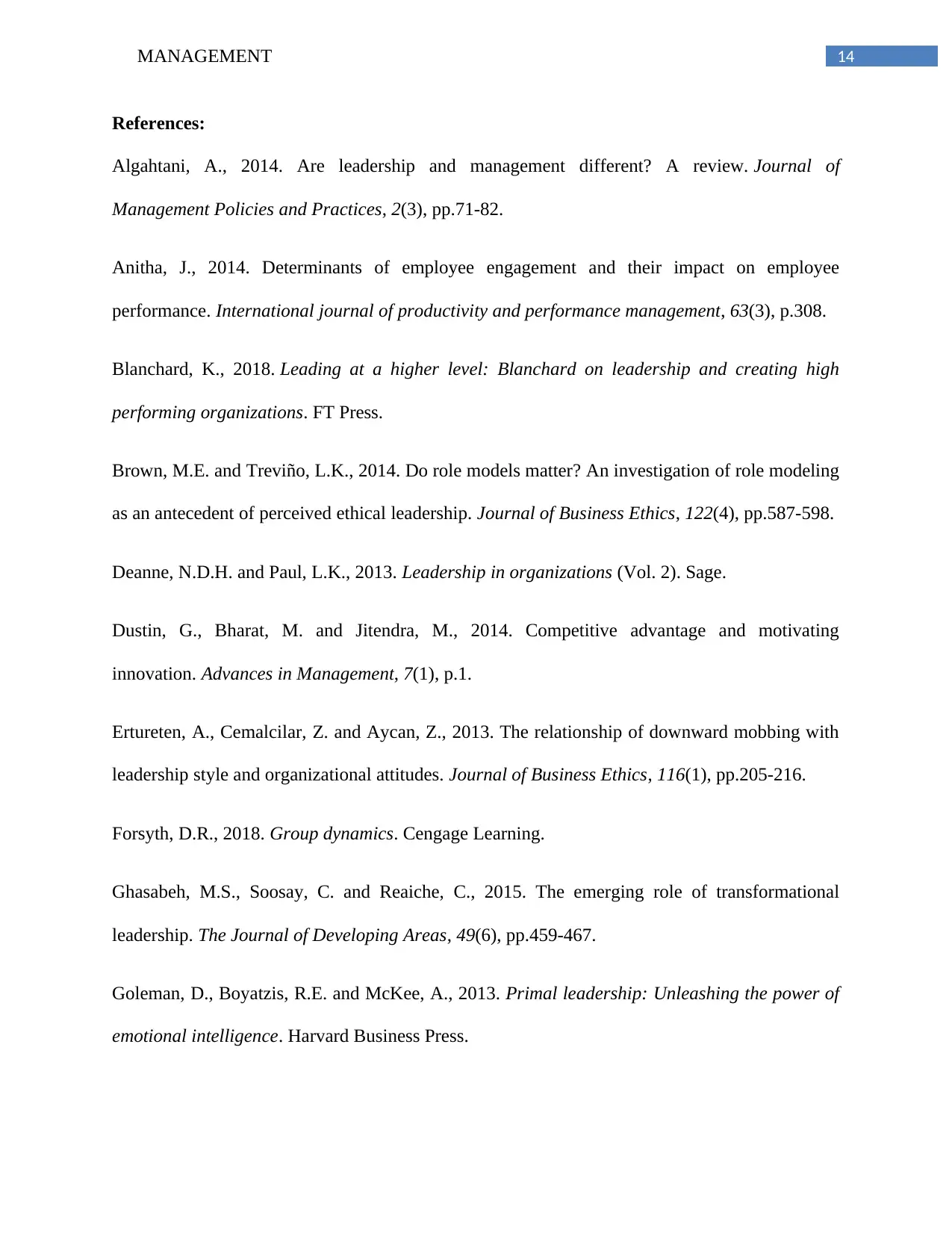
14MANAGEMENT
References:
Algahtani, A., 2014. Are leadership and management different? A review. Journal of
Management Policies and Practices, 2(3), pp.71-82.
Anitha, J., 2014. Determinants of employee engagement and their impact on employee
performance. International journal of productivity and performance management, 63(3), p.308.
Blanchard, K., 2018. Leading at a higher level: Blanchard on leadership and creating high
performing organizations. FT Press.
Brown, M.E. and Treviño, L.K., 2014. Do role models matter? An investigation of role modeling
as an antecedent of perceived ethical leadership. Journal of Business Ethics, 122(4), pp.587-598.
Deanne, N.D.H. and Paul, L.K., 2013. Leadership in organizations (Vol. 2). Sage.
Dustin, G., Bharat, M. and Jitendra, M., 2014. Competitive advantage and motivating
innovation. Advances in Management, 7(1), p.1.
Ertureten, A., Cemalcilar, Z. and Aycan, Z., 2013. The relationship of downward mobbing with
leadership style and organizational attitudes. Journal of Business Ethics, 116(1), pp.205-216.
Forsyth, D.R., 2018. Group dynamics. Cengage Learning.
Ghasabeh, M.S., Soosay, C. and Reaiche, C., 2015. The emerging role of transformational
leadership. The Journal of Developing Areas, 49(6), pp.459-467.
Goleman, D., Boyatzis, R.E. and McKee, A., 2013. Primal leadership: Unleashing the power of
emotional intelligence. Harvard Business Press.
References:
Algahtani, A., 2014. Are leadership and management different? A review. Journal of
Management Policies and Practices, 2(3), pp.71-82.
Anitha, J., 2014. Determinants of employee engagement and their impact on employee
performance. International journal of productivity and performance management, 63(3), p.308.
Blanchard, K., 2018. Leading at a higher level: Blanchard on leadership and creating high
performing organizations. FT Press.
Brown, M.E. and Treviño, L.K., 2014. Do role models matter? An investigation of role modeling
as an antecedent of perceived ethical leadership. Journal of Business Ethics, 122(4), pp.587-598.
Deanne, N.D.H. and Paul, L.K., 2013. Leadership in organizations (Vol. 2). Sage.
Dustin, G., Bharat, M. and Jitendra, M., 2014. Competitive advantage and motivating
innovation. Advances in Management, 7(1), p.1.
Ertureten, A., Cemalcilar, Z. and Aycan, Z., 2013. The relationship of downward mobbing with
leadership style and organizational attitudes. Journal of Business Ethics, 116(1), pp.205-216.
Forsyth, D.R., 2018. Group dynamics. Cengage Learning.
Ghasabeh, M.S., Soosay, C. and Reaiche, C., 2015. The emerging role of transformational
leadership. The Journal of Developing Areas, 49(6), pp.459-467.
Goleman, D., Boyatzis, R.E. and McKee, A., 2013. Primal leadership: Unleashing the power of
emotional intelligence. Harvard Business Press.
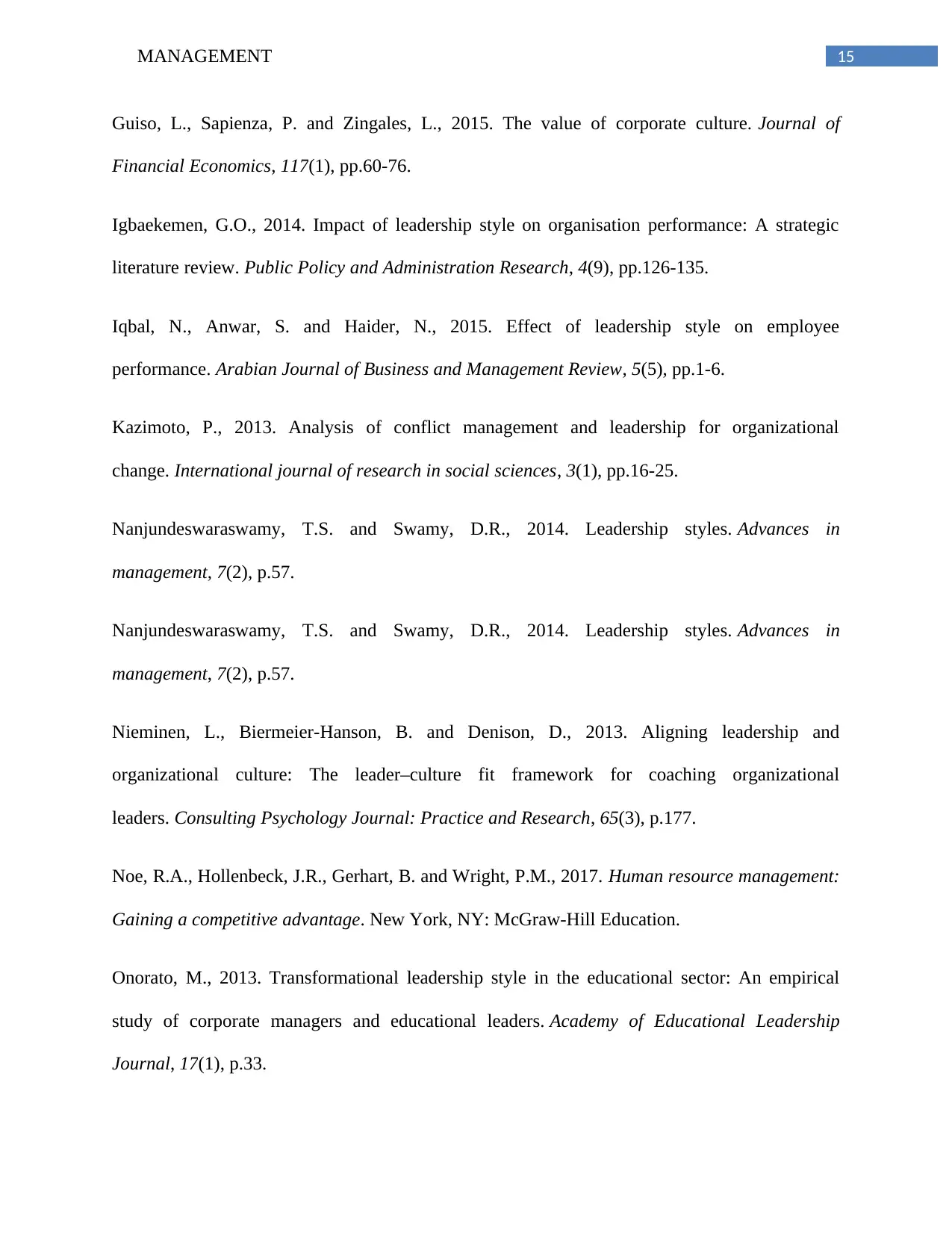
15MANAGEMENT
Guiso, L., Sapienza, P. and Zingales, L., 2015. The value of corporate culture. Journal of
Financial Economics, 117(1), pp.60-76.
Igbaekemen, G.O., 2014. Impact of leadership style on organisation performance: A strategic
literature review. Public Policy and Administration Research, 4(9), pp.126-135.
Iqbal, N., Anwar, S. and Haider, N., 2015. Effect of leadership style on employee
performance. Arabian Journal of Business and Management Review, 5(5), pp.1-6.
Kazimoto, P., 2013. Analysis of conflict management and leadership for organizational
change. International journal of research in social sciences, 3(1), pp.16-25.
Nanjundeswaraswamy, T.S. and Swamy, D.R., 2014. Leadership styles. Advances in
management, 7(2), p.57.
Nanjundeswaraswamy, T.S. and Swamy, D.R., 2014. Leadership styles. Advances in
management, 7(2), p.57.
Nieminen, L., Biermeier-Hanson, B. and Denison, D., 2013. Aligning leadership and
organizational culture: The leader–culture fit framework for coaching organizational
leaders. Consulting Psychology Journal: Practice and Research, 65(3), p.177.
Noe, R.A., Hollenbeck, J.R., Gerhart, B. and Wright, P.M., 2017. Human resource management:
Gaining a competitive advantage. New York, NY: McGraw-Hill Education.
Onorato, M., 2013. Transformational leadership style in the educational sector: An empirical
study of corporate managers and educational leaders. Academy of Educational Leadership
Journal, 17(1), p.33.
Guiso, L., Sapienza, P. and Zingales, L., 2015. The value of corporate culture. Journal of
Financial Economics, 117(1), pp.60-76.
Igbaekemen, G.O., 2014. Impact of leadership style on organisation performance: A strategic
literature review. Public Policy and Administration Research, 4(9), pp.126-135.
Iqbal, N., Anwar, S. and Haider, N., 2015. Effect of leadership style on employee
performance. Arabian Journal of Business and Management Review, 5(5), pp.1-6.
Kazimoto, P., 2013. Analysis of conflict management and leadership for organizational
change. International journal of research in social sciences, 3(1), pp.16-25.
Nanjundeswaraswamy, T.S. and Swamy, D.R., 2014. Leadership styles. Advances in
management, 7(2), p.57.
Nanjundeswaraswamy, T.S. and Swamy, D.R., 2014. Leadership styles. Advances in
management, 7(2), p.57.
Nieminen, L., Biermeier-Hanson, B. and Denison, D., 2013. Aligning leadership and
organizational culture: The leader–culture fit framework for coaching organizational
leaders. Consulting Psychology Journal: Practice and Research, 65(3), p.177.
Noe, R.A., Hollenbeck, J.R., Gerhart, B. and Wright, P.M., 2017. Human resource management:
Gaining a competitive advantage. New York, NY: McGraw-Hill Education.
Onorato, M., 2013. Transformational leadership style in the educational sector: An empirical
study of corporate managers and educational leaders. Academy of Educational Leadership
Journal, 17(1), p.33.
Secure Best Marks with AI Grader
Need help grading? Try our AI Grader for instant feedback on your assignments.
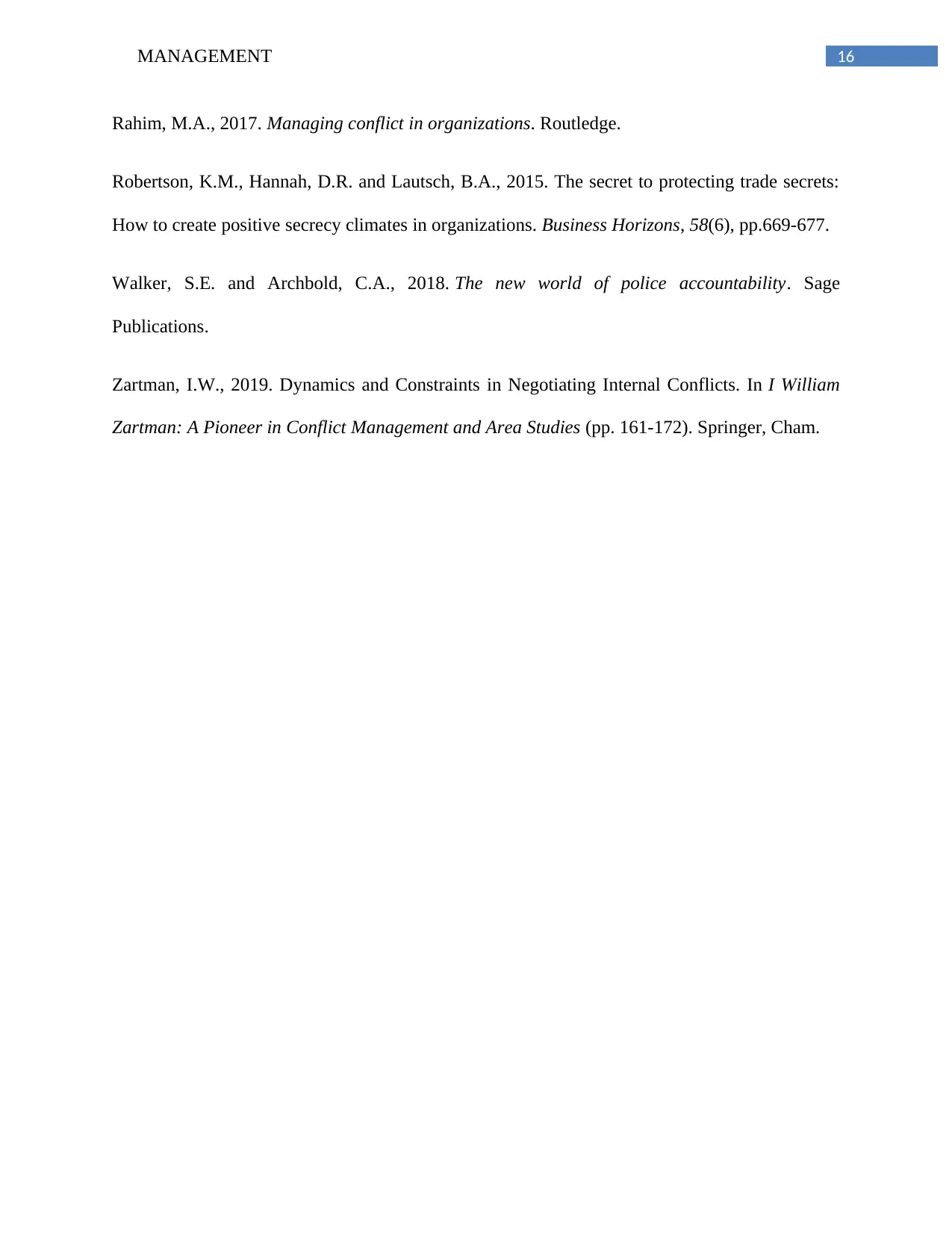
16MANAGEMENT
Rahim, M.A., 2017. Managing conflict in organizations. Routledge.
Robertson, K.M., Hannah, D.R. and Lautsch, B.A., 2015. The secret to protecting trade secrets:
How to create positive secrecy climates in organizations. Business Horizons, 58(6), pp.669-677.
Walker, S.E. and Archbold, C.A., 2018. The new world of police accountability. Sage
Publications.
Zartman, I.W., 2019. Dynamics and Constraints in Negotiating Internal Conflicts. In I William
Zartman: A Pioneer in Conflict Management and Area Studies (pp. 161-172). Springer, Cham.
Rahim, M.A., 2017. Managing conflict in organizations. Routledge.
Robertson, K.M., Hannah, D.R. and Lautsch, B.A., 2015. The secret to protecting trade secrets:
How to create positive secrecy climates in organizations. Business Horizons, 58(6), pp.669-677.
Walker, S.E. and Archbold, C.A., 2018. The new world of police accountability. Sage
Publications.
Zartman, I.W., 2019. Dynamics and Constraints in Negotiating Internal Conflicts. In I William
Zartman: A Pioneer in Conflict Management and Area Studies (pp. 161-172). Springer, Cham.
1 out of 17
Related Documents
Your All-in-One AI-Powered Toolkit for Academic Success.
+13062052269
info@desklib.com
Available 24*7 on WhatsApp / Email
![[object Object]](/_next/static/media/star-bottom.7253800d.svg)
Unlock your academic potential
© 2024 | Zucol Services PVT LTD | All rights reserved.





